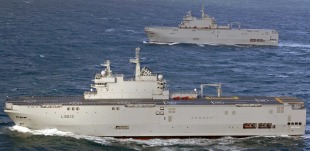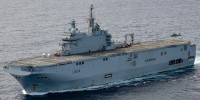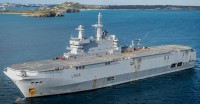Mistral-class amphibious assault ship
Basic information
Ship measurements
Machine
- 3 * Wärtsilä diesel-alternators 16 V32 (6.2 MW)
- 1 * Wärtsilä Vaasa auxiliary diesel-alternator 18V200 (3 MW)
- 2 * Rolls-Royce Mermaid azimuth thrusters (2 * 7 MW), 2 * five-bladed propellers
Personnel
Combat assets
- 70 * vehicles (including 13 * Leclerc tank) or a 40 * Leclerc tank battalion
- 4 * chaland de transport de matériel landing craft
- EDA-R/S Amphibious Landing Craft (S models being delivered from 2021)
- Landing Craft Air Cushion (2 could be carried but not acquired by French Navy)
- DRBN-38A Decca Bridgemaster E250 navigation radar
- MRR3D-NG air/surface sentry radar
- 2 * optronic fire control systems
- 2 * Simbad missile systems
- 2 * 20 mm modèle F2 gun
- 2 * 30 mm Breda-Mauser
- 2 * 7.62mm M134 miniguns
- 4 * 12.7 mm M2HB Browning machine guns
- 16 * heavy or 35 * light helicopters
The Mistral class is a class of five amphibious assault ships built by France. Also known as helicopter carriers, and referred to as «projection and command ships», a Mistral-class ship is capable of transporting and deploying 16 NH90 or Tiger helicopters, four landing craft, up to 70 vehicles including 13 Leclerc tanks, or a 40-strong Leclerc tank battalion, and 450 soldiers. The ships are equipped with a 69-bed hospital, and are capable of serving as part of a NATO Response Force, or with United Nations or European Union peace-keeping forces. Three ships of the class are in service in the French Navy: Mistral, Tonnerre, and Dixmude.
At Euronaval 1998, France confirmed plans to build vessels based on the BIP-19 concept. Approval for construction of two ships, Mistral and Tonnerre, was received on 8 December 2000. A construction contract was published on 22 December and, after getting the public purchase authority's approval (Union des groupements d'achats publics, UGAP) on 13 July 2001, was awarded to DCN and Chantiers de l'Atlantique in late July. An engineering design team was established at Saint-Nazaire in September 2001 and, following consultation between DCA and the Délégation Générale pour l'Armement (General Delegation for Ordnance, DGA), began to adapt the BIP-19 design. In parallel, the concept was refined by DGA, DCN, the Chief of the Defence Staff and Chantiers de l'Atlantique. During the design validation process, a 1⁄120th scale model was built and tested in a wind tunnel, revealing that in strong crosswinds, the ship's height and elongated superstructures created turbulence along the flight deck. The design was altered to minimise the effects and provide better conditions for helicopter operations.
The ships were constructed at various locations in two major and several minor components and united on completion. DCN, the head of construction and responsible for 60% of the value of construction and 55% of the work time, assembled the engines in Lorient, combat systems in Toulon, and the rear half of the ship, including the island superstructure, in Brest. STX Europe, a subsidiary of STX Shipbuilding of South Korea, constructed the forward halves of each ship in Saint-Nazaire, and was responsible for transporting them to DCN's Brest shipyard for final assembly. Other companies were involved in the construction: some work was outsourced to Gdańska Stocznia «Remontowa», while Thales supplied radars and communications systems. Each ship was predicted to take 34 months to complete, with design and construction for both costing 685 million Euros (approximately the same cost for a single ship based on HMS Ocean or USS San Antonio, and approximately the same cost as the preceding Foudre-class amphibious ships, which displaced half the tonnage of the Mistral class and took 46.5 months to complete).
DCN laid the keels for the aft part of both ships in 2002; Mistral on 9 July, and Tonnerre on 13 December. Chantiers de l'Atlantique laid the keel of the forward part of Mistral on 28 January 2003, and of Tonnerre later. The first block of the rear of Tonnerre was put in a dry dock on 26 August 2003, and that of Mistral on 23 October 2003. The two aft sections were assembled side by side in the same dry dock. The forward section of Mistral left Saint-Nazaire under tow on 16 July 2004 and arrived in Brest on 19 July 2004. On 30 July, the combination of the two halves through a process similar to jumboisation began in dock no. 9. Tonnerre's forward section arrived in Brest on 2 May 2005 and underwent the same procedure.
Mistral was launched on schedule on 6 October 2004, while Tonnerre was launched on 26 July 2005. Delivery was scheduled for late 2005 and early 2006 respectively, but was postponed for over a year due to issues with the SENIT 9 sensor system and deterioration to the linoleum deck covering of the forward sections. They were commissioned into the French Navy on 15 December 2006 and 1 August 2007, respectively.
The 2008 French White Paper on Defence and National Security forecast that two more BPCs would be in French Navy service by 2020. In 2009, a third ship was ordered earlier than expected as part of the French government's response to the recession which began in 2008. Construction began on 18 April 2009 in Saint-Nazaire; the entire ship was built there due to cost constraints. On 17 December 2009, it was announced that this third ship would be named Dixmude. It had been suggested to use the historic name of Jeanne d'Arc following the decommissioning of the helicopter cruiser of that name in 2010, but it was opposed by some French naval circles because France no longer operated a dedicated training ship (the traditional role of warships named Jeanne d'Arc) and now rotated the training role between multiple ships in the fleet. The possibility of a fourth Mistral-class ship was officially abandoned in the 2013 French White Paper on Defence and National Security.
Based on displacement tonnage, Mistral and Tonnerre are the largest ships in the French Navy after the nuclear-powered aircraft carrier Charles de Gaulle, for roughly the same height above water.
The flight deck of each ship is approximately 6,400 square metres (69,000 sq ft). The deck has six helicopter landing spots, one of which is capable of supporting a 33-tonne helicopter. The 1,800-square-metre (19,000 sq ft) hangar deck can hold 16 helicopters, and includes a maintenance area with an overhead crane. To aid launch and recovery, a DRBN-38A Decca Bridgemaster E250 landing radar and an optical landing system are used.
The flight and hangar decks are connected by two aircraft lifts, each capable of lifting 13 tonnes. The 225-square-metre (2,420 sq ft) main lift is located near the stern of the ship, on the centreline, and is large enough for helicopters to be moved with their rotors in flight configuration. The 120 square metres (1,300 sq ft) auxiliary lift is located aft of the island superstructure.
Every helicopter operated by the French military is capable of flying from these ships. On 8 February 2005, a Westland Lynx of the Navy and a Cougar landed on Mistral. The first landing of a NH90 took place on 9 March 2006. Half of the air group of the BPCs is to be constituted of NH-90s, the other half being composed of Tigre attack helicopters. On 19 April 2007, Puma, Écureuil and Panther helicopters landed on Tonnerre. On 10 May 2007, a MH-53E Sea Dragon of the US Navy landed on her reinforced helicopter spot off the U.S. Naval Station Norfolk.
According to Mistral's first commanding officer, Capitaine de vaisseau Gilles Humeau, the size of the flight and hangar decks would allow the operation of up to thirty helicopters. Mistral aviation capabilities approach those of the Wasp-class amphibious assault ships, for roughly 40% the cost and crew requirements of the American ship.
Mistral-class ships can accommodate up to 450 soldiers, although this can be doubled for short-term deployments. The 2,650-square-metre (28,500 sq ft) vehicle hangar can carry a 40-strong Leclerc tank battalion, or a 13-strong Leclerc tank company and 46 other vehicles. By comparison, Foudre-class ships can carry up to 100 vehicles, including 22 AMX-30 tanks, in the significantly smaller 1,000-square-metre (11,000 sq ft) deck.
The 885-square-metre (9,530 sq ft) well deck can accommodate four landing craft. The ships are capable of operating two LCAC hovercraft, and although the French Navy appears to have no intention of purchasing any LCACs, this capability improves the class' ability to interoperate with the United States Marine Corps and the British Royal Navy. Instead the DGA ordered eight French-designed 59-tonne EDA-R (Engin de débarquement amphibie rapide) catamarans for operation from the Mistral class. The EDA-S Amphibious Standard Landing Craft (Engins de Débarquement Amphibie – Standards) were subsequently ordered to replace CTM landing craft. These landing craft began delivery in 2021. Eight are envisaged for operation from the Mistral class and they have a payload capacity of 65 to 80 tonnes and a maximum speed of 11 knots (20 km/h; 13 mph) at full load.
Mistral-class ships can be used as command and control ships, with a 850-square-metre (9,100 sq ft) command centre which can host up to 150 personnel. Information from the ship's sensors is centralised in the SENIT system (Système d'Exploitation Navale des Informations Tactiques, «System for Naval Usage of Tactical Information»), a derivative of the US Navy's Naval Tactical Data System (NTDS). Problems in the development of the SENIT 9 revision contributed to the one-year delay in the delivery of the two ships. SENIT 9 is based around Thales' tri-dimensional MRR3D-NG Multi Role Radar, which operates on the C band and incorporates IFF capabilities. SENIT 9 can also be connected to NATO data exchange formats through Link 11, Link 16 and Link 22.
For communications, the Mistral-class ships use the SYRACUSE satellite system, based on French satellites SYRACUSE 3-A and SYRACUSE 3-B which provide 45% of the Super High Frequency secured communications of NATO. From 18 to 24 June 2007, a secure video conference was held twice a day between Tonnerre, then sailing from Brazil to South Africa, and VIP visitors at the Paris Air Show.
As built, the two Mistral-class ships were armed with two Simbad launchers for Mistral missiles and four 12.7 mm M2-HB Browning machine guns. Two Breda-Mauser 30 mm/70 guns are also included in the design, though not installed as of 2009. Following the experiences of French naval commanders during Opération Baliste, the French deployment to aid European citizens in Lebanon during the 2006 war, proposals to improve the self-defence capabilities of the two Mistral-class ships were supported by one of France's chiefs of staff. One suggestion is to upgrade the dual-launching, manual Simbad launchers to quadruple-launching, automatic Tetral launchers.
Incidents such as the near-loss of the Israeli corvette INS Hanit to a Hezbollah-fired anti-ship missile during the 2006 Lebanon War have shown the vulnerability of modern warships to asymmetric threats, with the Mistral-class ships considered under-equipped for self-defence in such a situation. Consequently, Mistral and Tonnerre cannot be deployed into hostile waters without sufficient escorting ships. This problem is compounded by the small number of escort ships in the French Navy; there is a five-year gap between the decommissioning of the Suffren-class frigates and the commissioning of their replacements, the Horizon-class and FREMM frigates.
In late 2011, the French Navy selected the NARWHAL20 remote weapon station (RWS) to equip Mistral ships for close-in self-defense. Nexter Systems will deliver two NARWHAL20B guns for each ship, chambered in 20×139mm ammunition, with one gun covering the port bow and the other covering the starboard stern. Dixmude was the first of the vessels outfitted with the cannons in March 2016.
In late 2013, the French Navy equipped all three Mistrals with two M134 Miniguns each; intended for close-in self-defence against asymmetric threats faced during anti-piracy operations, such as speedboats and suicide boats.
In December 2014, the French Navy awarded a contract to Airbus to study the integration of the Multiple Launch Rocket System (MLRS) on Mistrals. This is to increase the ships' naval fire support capabilities, as 76 mm and 100 mm guns have been determined to have insufficient range and lethality. The MLRS is in French Army service, using a GPS-guided rocket with a range of 70 km (43 mi) and a unitary 90 kg (200 lb) high-explosive warhead.
Each ship carries a NATO Role 3 medical facility, i.e., equivalent to the field hospital of an Army division or army corps, or to the hospital of a 25,000-inhabitant city, complete with dentistry, diagnostics, specialist surgical and medical capabilities, food hygiene and psychological capabilities. A Syracuse-based telemedicine system allows complex specialised surgery to be performed.
The 900 m2 (9,700 sq ft) hospital provides 20 rooms and 69 hospitalisation beds, of which 7 are fit for intensive care. The two surgery blocks come complete with a radiology room providing digital radiography and ultrasonography, and that can be fitted with a mobile CT scanner. 50 medicalised beds are kept in reserve and can be installed in a helicopter hangar to extend the capacity of the hospital in case of emergency.
The Mistral class are the first ships of the French Navy to use azimuth thrusters. The thrusters are powered by electricity from five 16-cylinder Wärtsilä 16V32 diesel alternators, and can be oriented in any angle. This propulsion technology gives the ships significant manoeuvering capabilities, as well as freeing up space normally reserved for propeller shafts.
The long-term reliability of azimuth thrusters in military use is yet to be rigorously studied, but the technology has been employed aboard ships in several navies, including the Dutch Rotterdam class, the Spanish Galicia class, and the Canadian Kingston class.
The space gained by the use of the azimuth thrusters allowed for the construction of accommodation areas where no pipes or machinery are visible. Located in the forward section of the ship, crew cabins aboard Mistral-class ships are comparable in comfort levels to passenger cabins aboard contemporary cruise ships. Each of the fifteen officers have an individual cabin. Senior non-commissioned officers share two-man cabins, while junior crew and embarked troops use four- or six-person cabins. Conditions in these accommodation areas are said to be better than in most barracks of the French Foreign Legion, and when United States Navy vice-admiral Mark Fitzgerald inspected one of the Mistral-class ships in May 2007, it was claimed that he would have used the same accommodation area to host a crew three times the size of Mistral's complement.
Export
Since 1997, and particularly since the Euronaval 2007, the Mistral type has been promoted for export. The «BPC family» comprises the BPC 140 (13,500 tonnes), the BPC 160 (16,700 tonnes) and the BPC 250 (24,542 tonnes, 214.5 metres (704 ft) long). The BPC 250 was the design from which the final Mistral-class design was derived: the reduction in length and other modifications were a price-saving exercise. The BPC 250 concept was one of two designs selected for the Canberra-class amphibious warfare ships, to be constructed for the Royal Australian Navy. The design finally chosen was the Spanish Buque de Proyección Estratégica-class amphibious ship.
Ships5
- Comments
 en
en ru
ru uk
uk




 Egyptian Navy
Egyptian Navy French Navy (Marine Nationale)
French Navy (Marine Nationale) Naval Group (formerly DCNS)
Naval Group (formerly DCNS)



